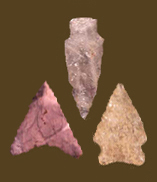
|
LEHIGH/KOENS-CRISPIN
Chronology The Lehigh/Koens-Crispin point dates to the Late Archaic period. Custer (1996a) suggests a date range of 2500 to 1700 BC. Others give it a narrower range. Steponaitis (1980) places it between 3900 and 3700 BP (2450-2100 BC in calendar years), while Ritchie (1971) and Justice (1987) link it to the morphologically-similar Snook Kill point at 3800 to 3600 BP. Kinsey (1972) reports radiocarbon dates ranging from 1720 to 1470 BC (roughly 2100-1850 BC in calendar years). Wall et al. (1996) suggest that variants of the type could extend as late as the Middle Woodland. Description Blade: The blade size and shape can range from a long, narrow, lanceolate form to larger and broader ovate forms, and is often asymmetric. The blade is well-made and rather thin for its width. The edges of the blade are typically well-shaped to remove manufacturing irregularities. Haft Element: The stem is generally short in relation to the blade length. Distinct shoulders form at the junction of the blade and stem, and they can be sharp or rounded. A majority of examples have contracting stems, although straight or even slightly expanding stems occur. The base is mostly excurvate or straight, thinned, and often ground. Size: The Lehigh/Koens-Crispin point is usually fairly large. Length ranges from 44 to 120 mm. Width ranges from 30 to 48 mm. Thickness ranges from 5 to 12 mm. Technique of manufacture: The point was manufactured by soft percussion, with little or no pressure retouching. The flakes are very wide and overlap at the center of the blade. Material: In a sample of 89 Lehigh/Koens-Crispin points from the lower Patuxent drainage, Steponaitis (1980) reported that 48% were quartzite, followed by rhyolite (30%), quartz (21%), and argillite (1%). In the area surrounding Zekiah Swamp on the lower Potomac, Wanser (1982) found that 51% of 126 Lehigh/Koens-Crispin points were rhyolite, with 26% quartz, 19% quartzite, and 4% chert or other materials. In the Monocacy River drainage, 80% of 38 Lehigh/Koens-Crispins were rhyolite, with 5% each of quartz, quartzite, chert, and argillite (Kavanagh 1982). Rhyolite Lehigh/Koens-Crispin points predominate in the middle Potomac River Valley (Hranicky 2002). In Delaware, they are commonly made from argillite, rhyolite, and jasper (Custer 1996a). Discussion The nomenclature of the Lehigh/Koens-Crispin point is confusing. Regional names for the type – such as Lehigh, Koens-Crispin, and Snook Kill – were proposed at various times, and first two names are now commonly combined. The regional variants are mostly distinguished by lithic material preferences (Kinsey 1972). The Lehigh/Koens-Crispin overlaps in time with the Savannah River point, and the two share certain morphological similarities. In Virginia, two short-stemmed local variants of the Savannah River, named the Cattle Run (Geier 1996) and the Island Swamp (McAvoy and McAvoy 1997), have been defined, and they bear a resemblance to Lehigh/Koens-Crispin points. Defined in Literature Other Names Used Snook Kill References |
![]()
Search by Shape:
(See Projectile Point Typology) |

|
Thank you for visiting our website. If you have any
questions, comments, Copyright © 2002 by |

|

 Defining Attributes
Defining Attributes